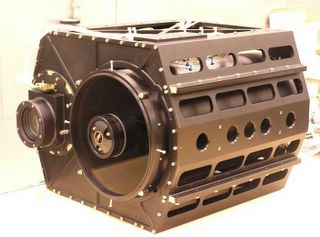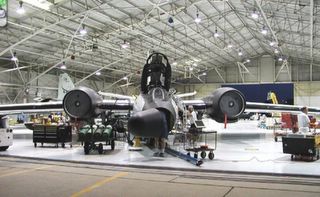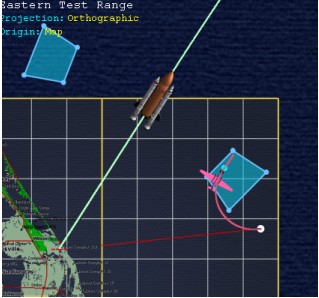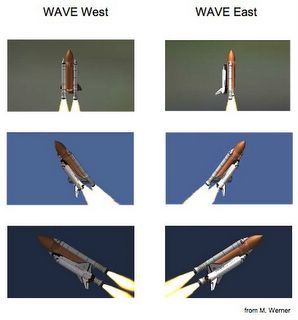I have posted previously about another workhorse in the U.S. research aircraft fleet, the WB-57. For some time now, the two NASA birds have been used to photograph shuttle launches. For the upcoming launch they were tasked with acquiring high-quality video from lift-off to just past the solid rocket booster (SRB) separation.

926 and 928...

These are the two NASA WBs - known from their fleet numbers as simply 926 and 928. They are modified B-57 Canberras, made by Martin based on the original English Electric design. Both were originally made in 1963, and their wings were modified in 1967 by General Dynamics for high-altitude reconnaisance missions. 926 was RB-57D 53-3974 while in the USAF, and 928 was RB-57B 52-1536, and they most probably did high altitude sampling over US and Chinese nuclear tests. Lately they have flown through the exhaust plumes left by the shuttle's SRBs and main engines.

HDTV!

To provide high-quality imaging of the shuttle, SRBs and the external tank (ET) during ascent, both 926 and 928 will be carrying specially manufactured imaging systems. NASA contracted the Aerospace Corporation and the Southern Research Institute to put together the equipment and plan the mission for the WBs. This is a shot of the imaging package - a Celestron telescope lens provides an aperture for near infra-red (NIR) and HDTV imaging, and an NTSC system provides the initial sighting for the tracking software.

nose job

In order to track the shuttle's ascent, a turret and gimbal system will be attached to the nose of the aircraft. This is the hangar at JSC where they are doing the first mods to attach the turret.

flankers

During the actual launch, the WBs will fly at 60,000 feet along tracks on either side of the ascent path, giving views of the orbiter, ET and SRBs through SRB separation+10. The technical constraint areas for the position of the WBs during a particular ascent moment are the blue boxes.

RTF!

These are simulations done by the Aerospace Corp. for what the HDTV FOV should be from both aircraft, at different times during the ascent. WAVE stands for WB-57 Ascent Video Experiment.
Of course, since the data will be in HDTV, I am sure that NASA's PR Office is already salivating. But no, it will not be shown live - the data is being recorded on board, and will have to be downloaded at Patrick AFB when the birds return. Time to release, probably about launch + 30 hours. I can't wait. I hope to be in Orlando during the launch window, and will keep my eyes glued to the East.
No comments:
Post a Comment